Building a Supplement Stack for Long-Term Mood Support
🌞 Introduction: Mood as a Biological Ecosystem
Mood is not random.
It’s the language your body speaks when describing the state of your nervous system, your hormones, your gut, and your energy metabolism.
When one of those systems drifts out of balance, your emotional landscape follows.
Fatigue can masquerade as sadness.
Inflammation can feel like irritability.
Low magnesium can feel like anxiety.
The goal of supplementation isn’t to chase away every feeling — it’s to build resilience so your emotions can move freely without controlling you.
This guide helps you design a long-term supplement stack that sustains emotional equilibrium, sharpens focus, and protects mental clarity for years to come.
Looking for supplements for Brain Fog? Click here.
🧠 Section 1: Understanding the Biology of Mood

Mood stability relies on four pillars:
Neurotransmitters — serotonin, dopamine, GABA, and norepinephrine.
Hormonal balance — cortisol, thyroid, estrogen/testosterone.
Inflammation control — keeping cytokines low and brain energy high.
Nervous-system tone — vagus-nerve regulation and mitochondrial vitality.
The stack you’ll build should feed all four pillars simultaneously, not over-stimulate one at the expense of another.
“The most effective mood protocol isn’t the most powerful — it’s the most balanced.”
🌿 Section 2: The Foundation Layer — Nutrient Repletion
Before adding fancy nootropics or herbs, repair the basics.
Deficiencies quietly sabotage mood chemistry every day.
🧂 Magnesium: The Great Relaxer
Calms the HPA (stress) axis.
Supports GABA receptors for tranquility.
Needed for serotonin and melatonin synthesis.
Form: glycinate or threonate.
Dose: 200–400 mg nightly.
☀️ Vitamin D + K2
Regulates serotonin and dopamine genes.
Stabilizes circadian rhythm and resilience to stress.
Dose: 1 000–4 000 IU daily with fat.
⚙️ B-Complex (methylated)
B6 and B12 enable neurotransmitter production.
Folate improves serotonin receptor sensitivity.
Dose: one capsule with breakfast.
🧬 Zinc + Selenium
Support thyroid function and dopamine balance.
Zinc deficiency is linked to low mood and fatigue.
These micronutrients form the metabolic groundwork on which everything else functions.
🌊 Section 3: The Structural Layer — Omega - 3s and Lipid Balance
Your neurons are wrapped in fat.
The quality of that fat determines how well signals travel.
EPA (eicosapentaenoic acid): anti-inflammatory; reduces depressive symptoms.
DHA (docosahexaenoic acid): structural; enhances calm cognition.
Target ratio: at least 60 % EPA : 40 % DHA.
Dose: 1 000–2 000 mg combined EPA/DHA daily with meals.
Pair with phosphatidylserine for cell-membrane elasticity and cortisol regulation.
🧘 Section 4: The Calming Layer — Adaptogens and Amino Acids
Adaptogens don’t sedate; they teach your body how to respond to stress.
🌿 Ashwagandha
Lowers cortisol and balances thyroid hormones.
Improves sleep depth and emotional recovery.
Dose: 300–600 mg extract daily.
🌺 Rhodiola rosea
Enhances dopamine tone and mental stamina.
Prevents burnout from chronic stress.
Dose: 200–400 mg in the morning.
🍵 L-Theanine
Promotes alpha brain-waves and calm alertness.
Complements caffeine or supports meditation.
Dose: 200 mg once or twice daily.
Together they create the resilience triad — calm energy, emotional steadiness, and sharper awareness.
Looking for supplements for Brain Fog? Click here.
🌾 Section 5: The Gut–Brain Layer — Serotonin from Within
About 90 % of serotonin is made in the gut.
If your microbiome is inflamed or imbalanced, mood suffers.
💊 Probiotics
Strains shown to influence mood:
Lactobacillus helveticus R0052
Bifidobacterium longum R0175
Dose: 1 billion CFU daily.
🌿 Prebiotics (fiber)
Feed the beneficial species that produce GABA and serotonin precursors.
Sources: inulin, resistant starch, green banana flour.
🌼 Digestive Support
Bitters or ginger improve nutrient absorption — more nutrients = more neurotransmitters.
🌞 Section 6: The Energy Layer — Mitochondrial Mood
Low cellular energy feels like low mood.
⚡ CoQ10
Powers ATP production.
Reduces oxidative stress in neurons.
Dose: 100–200 mg with meals.
💧 Acetyl-L-Carnitine (ALCAR)
Transports fatty acids into mitochondria.
Improves motivation and focus.
Dose: 500–1 000 mg morning.
🔋 Alpha-Lipoic Acid
Regenerates antioxidants like vitamin C & E.
Enhances insulin sensitivity for steady energy.
When mitochondria thrive, emotional endurance follows.
🌙 Section 7: The Sleep–Mood Interface
Chronic stress and mood swings often trace back to poor sleep.
Targeting nighttime calm is essential for sustainable emotional repair.
💤 Magnesium (threonate) + Glycine
Muscle relaxation and temperature regulation.
🪷 L-Theanine + Apigenin (from chamomile)
Induce alpha-then-theta brain transition.
🌺 Ashwagandha or Holy Basil
Calm cortisol spikes that wake you at 3 a.m.
Good sleep isn’t the absence of noise — it’s biochemical trust restored.
🧘 Section 8: The Cognitive-Mood Enhancers
Once foundation and calm are solid, add gentle nootropics that lift clarity without agitation.
🍄 Lion’s Mane Mushroom
Stimulates Nerve Growth Factor (NGF).
Enhances focus and emotional insight.
🌿 Bacopa Monnieri
Improves memory and reduces anxiety through serotonin modulation.
💡 N-Acetyl Cysteine (NAC)
Regulates glutamate; supports emotional control.
Detoxifies oxidative stress in the brain.
These work cumulatively — subtle improvements compound into resilience.
🌤️ Section 9: Putting It Together — The Long-Term Stack
| Category | Supplement | Timing | Core Benefit |
|---|---|---|---|
| Foundation | Magnesium + B-complex + Vitamin D | Morning / Night | Baseline calm & mood chemistry |
| Lipid | Omega-3 + Phosphatidylserine | Morning | Neural structure & stress buffering |
| Adaptogen | Ashwagandha / Rhodiola | Morning or Evening | Cortisol modulation |
| Amino Acid | L-Theanine + Glycine | Day / Night | Relaxed alertness & restorative sleep |
| Gut | Probiotics + Prebiotics | Morning | Serotonin from gut |
| Mitochondrial | CoQ10 + ALCAR | Morning | Energy & focus |
| Cognitive | Lion’s Mane / NAC | Mid-day | Neuroprotection & reflection |
Start slow. Introduce one new element every 1–2 weeks and track mood, energy, and sleep.
🧩 Section 10: Lifestyle Synergy
Supplements tune biology; lifestyle directs it.
| Habit | Mechanism | Synergy |
|---|---|---|
| Breathwork | Activates vagus nerve | Enhances GABA & magnesium effect |
| Sunlight exposure | Entrains circadian rhythm | Boosts Vitamin D & melatonin |
| Resistance training | Raises dopamine & BDNF | Pairs with Omega-3s |
| Mindful journaling | Improves emotional literacy | Complements adaptogens |
| Sleep routine | Restores cortisol rhythm | Works with Ashwagandha stack |
The more consistent your environment, the less your biochemistry has to fight it.
⚠️ Section 11: Common Mistakes
🚫 Starting too many supplements at once.
🚫 Using stimulants to fake energy.
🚫 Neglecting diet and hydration.
🚫 Skipping rest days for the adrenals.
Fix: simplify, cycle adaptogens, and give your nervous system time to adapt.
🌿 Section 12: Cycling and Longevity Strategy
Long-term mood support means avoiding tolerance.
Cycle adaptogens (8–12 weeks on / 2 off).
Take B-vitamins and magnesium continuously.
Rest nootropics 1–2 days per week.
Re-evaluate labs every 6 months (Vitamin D, zinc, ferritin).
Your stack should evolve with seasons, stress levels, and emotional growth.
🧘 Section 13: The Role of Therapy and Mindfulness

Supplements stabilize chemistry; therapy rewires perspective.
Both are required for lasting mood equilibrium.
When emotional stability returns, awareness deepens.
You respond to life — you don’t react to it.
“Biology gives you the calm. Awareness teaches you what to do with it.”
Looking for online therapy ? Click Here.
🌺 Section 14: Sample Morning–Evening Routine
Morning (8 a.m.)
B-complex + Vitamin D + Omega-3 + Rhodiola + CoQ10.
Breathwork or 10 min sunlight.
Afternoon (1 p.m.)
Lion’s Mane + ALCAR for focus.
Hydration with electrolytes.
Evening (7 p.m.)
Magnesium glycinate + Ashwagandha + Probiotics.
Light dinner; gratitude journaling.
Night (10 p.m.)
Glycine + Chamomile tea.
Digital sunset and deep breathing.
🌿 Section 15: Measuring Progress
Use a Mood-Sleep-Energy tracker with simple 1–10 scales.
Watch for patterns over 3–4 weeks:
✅ Fewer emotional spikes.
✅ More restorative sleep.
✅ Sustained afternoon energy.
✅ Sharper focus under stress.
When stability becomes normal, you’ve built resilience — not dependency.
🌞 Section 16: The Science of Consistency
Long-term benefit comes from nutrient saturation and habit repetition, not megadoses.
The brain rewires slowly; mitochondria rebuild gradually; inflammation cools over months.
Think garden, not pharmacy: nurture daily, harvest slowly.
🌸 Section 17: When to Seek Medical Guidance
Persistent depression or anxiety lasting > 3 weeks.
Suicidal thoughts or manic symptoms.
Polypharmacy or chronic illness (thyroid, diabetes, etc.).
Work with a practitioner trained in integrative psychiatry to personalize dosages and rule out interactions.
🌿 Section 18: Supplements to Approach Carefully
| Category | Why Caution Matters |
|---|---|
| 5-HTP / SAMe | Risk of serotonin overload if on antidepressants |
| Kava / Valerian | May cause drowsiness or tolerance |
| High-dose Rhodiola | Can feel stimulating in anxious types |
| St. John’s Wort | Drug–drug interactions (birth control, SSRIs) |
Natural ≠ harmless — precision creates safety.
🌺 Section 19: Emotional Nutrition
Food itself is the first supplement.
Protein = amino acids for neurotransmitters.
Complex carbs = steady serotonin.
Omega-3 fats = membrane health.
Polyphenols = antioxidant calm.
Supplements fill gaps; meals anchor biology in ritual.
Eat slowly — it’s emotional regulation disguised as lunch.
💫 Section 20: Integration — The Biology of Emotional Resilience
When your nervous system is nourished, stress no longer hijacks mood.
Magnesium smooths the current.
B-vitamins fire the circuits.
Omega-3s keep messages flowing.
Adaptogens hold the center.
Together, they form a biochemical environment of trust — one where joy, focus, and calm can coexist.
“Mood stability isn’t the absence of emotion — it’s the ability to return to center.”
🌼 Key Takeaways
✅ Start with nutrient foundations before advanced stacks.
✅ Use adaptogens and amino acids for calm strength.
✅ Support gut, mitochondria, and sleep for long-term stability.
✅ Cycle compounds, track progress, and pair with mindfulness.
✅ Balance > intensity — always.
📚 References
Sarris J. et al. (2016). Adjunctive nutrients in depression. Am J Psychiatry.
Panossian A. & Wikman G. (2010). Adaptogens and stress protection. Pharmaceuticals.
Boyle N.B. et al. (2017). Magnesium supplementation and mood. Nutrients.
Mischoulon D. & Freeman M.P. (2013). Omega-3s in psychiatry. Psychiatr Clin N Am.
Dinan T.G. & Cryan J.F. (2017). Microbiota and emotion. Nat Rev Gastroenterol Hepatol.
Related Posts
-
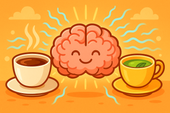
The Role of L-Theanine and Caffeine in Daily Motivation
Cortisol — often called the “stress hormone” — is both your alarm system and your reset button ⚡. It keeps you alert in the morning and helps you recover after challenges, but when it stays high too long, it drains your mood and energy. Learn how to balance cortisol naturally for steady focus, calm, and motivation. 🌿
-
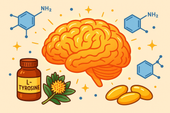
Supplements That Support Dopamine for Drive and Reward
Curcumin — the golden compound in turmeric — is more than a spice 🌿✨. It’s a powerful anti-inflammatory that protects dopamine neurons, supports brain clarity, and enhances mood. Learn how curcumin’s antioxidant properties help stabilize energy, reduce brain fog, and promote emotional resilience naturally. 🌼
-
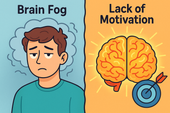
Brain Fog vs Lack of Motivation: What’s Really Holding You Back?
Hormones are the body’s invisible messengers — shaping energy, mood, focus, and motivation 🧠🌿. When they’re balanced, you feel clear, confident, and emotionally steady. Learn how key hormones like cortisol, serotonin, dopamine, and estrogen interact to influence your mental well-being and what you can do to keep them in harmony naturally. ✨
-

Supplements for Staying Collected During Disagreements
Science helps us understand why we feel, react, and change 🌿🧠. From brain chemistry to neurotransmitters and hormones, every emotional response has a biological root. Explore how research in neuroscience and psychology reveals practical ways to stay balanced, focused, and emotionally strong in daily life. 🔬✨
-

Managing Anger While Traveling
Supplements can help calm your nervous system and keep your emotions balanced while on the go 🌿. From magnesium and ashwagandha to L-theanine and omega-3s, learn how natural nutrients support stress resilience, focus, and emotional control — even through long flights, delays, and unpredictable travel days. ✈️
-

How to Keep Your Temper in Online Debates
Supplements can do more than fill nutritional gaps — they can help balance your energy, focus, and stress response naturally 🌿. From adaptogens to amino acids, the right nutrients support your brain chemistry and hormonal harmony for calm, steady productivity. Discover how supplements can build long-term resilience without the crash. ⚡🧠
-

Supplements to Stay Calm Before Public Speaking
Breathwork is one of the simplest yet most powerful tools for calming pre-performance stress 🌬️. By slowing and deepening your breathing, you lower cortisol, steady your heartbeat, and re-center your mind. Learn the science behind how controlled breathing activates your parasympathetic nervous system — helping you speak, perform, or focus with grounded confidence. 🌿
-

How to Handle Customer Service Stress Without Losing Your Cool 💬🧘♀️
Customer service can test even the calmest person’s patience. 😤 Learn how to handle difficult clients and daily pressure without losing your cool — through better mindset management, calming breathwork, and practical communication tools. Stay grounded, protect your energy, and transform stress into strength. 🌿
-
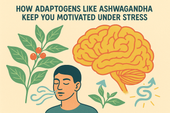
How Adaptogens Like Ashwagandha Keep You Motivated Under Stress
Feeling overwhelmed and unmotivated? 🌿 Discover how adaptogens like Ashwagandha can help you stay centered, focused, and energized under stress. Learn how supplements, breathwork, and therapy work together to restore your natural motivation and help you thrive — even during life’s toughest moments. 💪✨
-
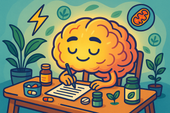
Supplements That Support Long-Term Productivity Without the Crash ⚡🌿
Cortisol — your body’s main stress hormone — can be both your best friend and worst enemy. ⚡ When balanced, it keeps you focused, energized, and ready to act. But when it stays high for too long, it leads to fatigue, anxiety, and emotional crashes. Learn how to regulate cortisol naturally through supplements, sleep, and stress management to maintain calm, steady productivity. 🌿
-
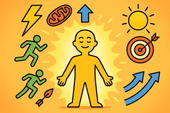
Why Energy Levels and Motivation Go Hand in Hand ⚡🧠
B-vitamins are the brain’s spark plugs 🔋. They turn food into fuel, support neurotransmitter production, and keep your mood, energy, and focus balanced. Learn how vitamins like B6, B9, and B12 work together to power the nervous system, reduce fatigue, and keep motivation high. 🌿
-
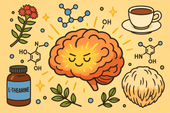
The Science of Motivation: Can Nootropics Help You Stay Focused? 🧠⚡
Nootropics are nature’s tools for sharper thinking and sustainable focus 🧠🌿. From Rhodiola and Lion’s Mane to L-theanine and Bacopa, these brain-boosting compounds enhance motivation, memory, and stress resilience. Learn the science behind how nootropics work — and how to use them safely for peak mental performance and clarity. ⚡
-
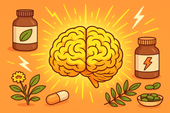
How Natural Supplements Can Boost Your Daily Drive
Cortisol is your body’s main stress hormone — powerful, necessary, but often misunderstood. ⚡ When balanced, it keeps you alert and energized; when chronically elevated, it drains mood, motivation, and focus. Learn how to regulate cortisol naturally through nutrition, supplements, and calming lifestyle habits for steady energy and emotional balance. 🌿
-
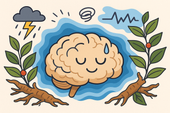
Ashwagandha for Stress and Low Mood
Breathwork is more than a relaxation tool — it’s a way to rewire your nervous system. 🌬️ Through intentional breathing, you can reduce stress hormones, improve focus, and calm emotional turbulence. This guide explores the science of breathwork and its powerful effects on mental clarity, resilience, and emotional regulation. 🌿
-
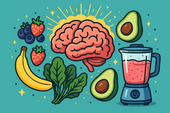
Mood-Boosting Smoothie Recipes
Your blood sugar affects far more than energy — it influences mood, focus, and emotional stability too 🍎. Learn how maintaining balanced glucose levels supports brain health, reduces anxiety, and prevents emotional crashes. Discover the foods and habits that keep your mind calm and your energy steady throughout the day. 🌿
-
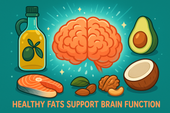
How Healthy Fats Support Brain Function
Your brain thrives on healthy fats 🧠💧. From omega-3s to MCTs, the right fats enhance focus, memory, and mood while protecting against inflammation and aging. This article explores how good fats — like those from olive oil, salmon, avocado, and nuts — build sharper thinking, emotional balance, and lasting brain vitality. 🌿
-
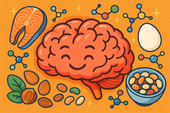
The Role of Protein in Mental Clarity
Protein isn’t just for muscles — it’s for your mind. 🧠 This guide explores how amino acids from high-quality protein fuel neurotransmitters, stabilize mood, and sharpen focus. Learn how balanced protein intake supports dopamine, serotonin, and energy regulation to boost mental clarity and emotional stability naturally. 🍳🌿
-
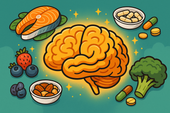
Nutrients That Support Emotional Stability
Your emotions are built from nutrients as much as from thoughts 🌿. This science-backed guide reveals the vitamins, minerals, and healthy fats that stabilize mood and reduce stress — from B-vitamins and magnesium to omega-3s and probiotics. Learn how balanced nutrition supports neurotransmitters, strengthens resilience, and promotes lasting calm and clarity 🧠✨.
-
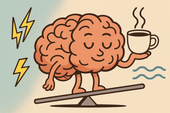
How Caffeine Affects Your Mood ☕
Your morning coffee might lift your spirits — but what’s really happening inside your brain? ☕ This in-depth guide explores how caffeine affects mood, motivation, dopamine, and stress. Learn how to enjoy caffeine mindfully without triggering anxiety, burnout, or emotional crashes. Discover the science behind your energy highs and lows — and how to find calm, sustainable focus. 🌿
-
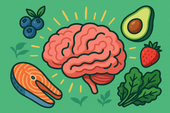
The Best Anti-Inflammatory Diet for Mental Health
Inflammation doesn’t just affect your body — it impacts your mood, focus, and emotional resilience too 🌿. This comprehensive guide reveals how an anti-inflammatory diet can support mental health by reducing neuroinflammation, balancing gut bacteria, and stabilizing blood sugar. Learn which foods to eat (and which to avoid) to protect your brain, boost serotonin, and promote lasting calm. 🧠✨
-
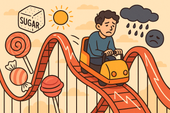
Why Sugar Spikes Can Worsen Depression
Sugar highs can make you feel good for a moment — but what comes next can fuel emotional crashes and deepen depression 🍭. This article explains how blood sugar spikes disrupt brain chemistry, increase inflammation, and destabilize serotonin. Learn how food, supplements, breathwork, and therapy can help you break the sugar–mood cycle and restore lasting emotional balance 🌿.
-
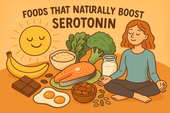
Foods That Naturally Boost Serotonin
Serotonin isn’t just a brain chemical — it’s your body’s built-in mood stabilizer 🌞. This in-depth guide explores how natural foods like salmon, eggs, bananas, and dark chocolate can elevate serotonin levels, while gut health, key nutrients, supplements, breathwork, and therapy create the perfect synergy for calm and emotional balance. Learn how to support your mind through diet, lifestyle, and mindset — naturally. 🌿
-
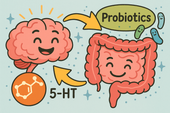
Probiotics for Mood Balance
-
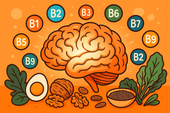
B-Vitamins and Their Role in Mental Health
Methylation is one of your body’s most important biochemical processes — influencing mood, energy, and focus. Powered by B-vitamins like B6, B9, and B12, it helps your brain create serotonin, detox efficiently, and maintain emotional balance. 🌿
-
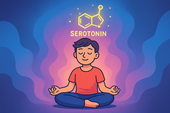
5-HTP for Serotonin Support
Calm isn’t just an emotion — it’s a physiological state where your body and mind finally sync in peace. By slowing your breath, softening your thoughts, and creating safety within, you restore the deep relaxation your nervous system craves. 🌿
-
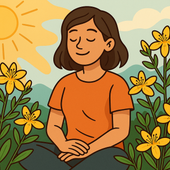
St. John’s Wort for Mild Depression
Antidepressants can be life-changing for many — but understanding how they work and what natural options like St. John’s Wort can complement them is key. Learn how both approaches affect brain chemistry, mood balance, and long-term emotional wellness. 🌿
-
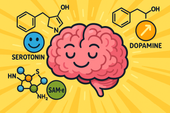
SAM-e: A Natural Mood Booster
Emotional regulation is the art of staying calm and grounded, even when life feels chaotic. By balancing your brain, body, and breath, you can respond with clarity instead of reacting from stress — building real emotional resilience and inner peace. 🌿
-

Rhodiola Rosea for Emotional Resilience
Neuroplasticity is your brain’s ability to grow, adapt, and heal — even after stress or trauma. Every thought, emotion, and habit reshapes your neural pathways, helping you build stronger emotional resilience, sharper focus, and lasting mental balance. 🌿
-
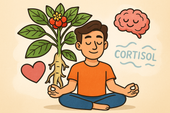
Ashwagandha for Stress and Low Mood
Adaptogens are nature’s stress balancers — powerful herbs like ashwagandha, rhodiola, and reishi that help your body adapt to tension, fatigue, and change. By regulating cortisol and supporting your nervous system, they build calm focus and emotional resilience from the inside out. 🌙
-
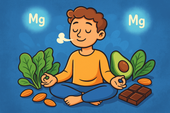
Magnesium’s Role in Emotional Regulation
Neuroscience helps us understand why we feel, think, and react the way we do. From brain chemistry and neural circuits to stress responses and emotional learning, the science of the brain reveals how our minds can heal, grow, and find balance. 🌿
-
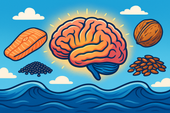
Omega-3 Fatty Acids and Emotional Well-Being
Nutrients aren’t just fuel — they’re communication signals that tell your brain and body how to function. From magnesium and vitamin D to omega-3s and B vitamins, the right mix of nutrients helps calm your mind, balance hormones, and support emotional and physical well-being. 🌙
-
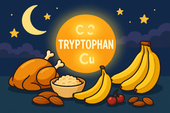
The Role of Tryptophan in Sleep Health
Mental health isn’t just the absence of illness — it’s the foundation of calm, focus, and emotional resilience. From managing stress and anxiety to nurturing self-compassion, understanding your mental well-being is the first step toward a balanced, more peaceful life. 🌿
-

Nutrients That Promote Nighttime Relaxation
Potassium does more than balance fluids — it also helps your body and mind relax at night. By calming nerves, reducing muscle tension, and supporting steady heart rhythm, potassium-rich foods like bananas, sweet potatoes, and coconut water can promote deeper, more restful sleep. 🌙
-
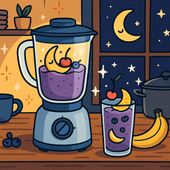
Sleep-Friendly Smoothie Recipes
Melatonin is your body’s natural sleep signal — a hormone that tells your brain when it’s time to rest. Learn how melatonin works, which foods and habits boost its production, and how to use it wisely for deeper, more restorative sleep without dependence. 💤
-
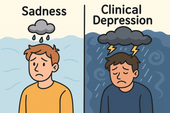
The Difference Between Sadness and Clinical Depression
Your emotions aren’t just in your mind — they’re written in your brain chemistry. Serotonin, dopamine, and GABA work together to regulate mood, motivation, and calm. When they fall out of balance, you may feel anxious, fatigued, or low. Learn how these brain chemicals influence your mental health and what you can do to restore harmony naturally. 🌿
-
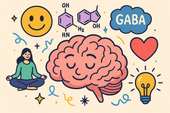
How Brain Chemistry Influences Mood
Your brain is a symphony of neurotransmitters — serotonin, dopamine, GABA, and more — working together to shape how you think and feel. When they’re balanced, you experience calm focus and emotional stability. When they’re not, mood swings and fatigue can follow. Learn how to naturally support these vital messengers for better mood and mental clarity. 🌿
-
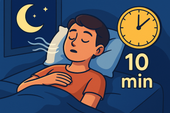
How to Fall Asleep in Under 10 Minutes
The military knows a few secrets about falling asleep fast — and they work even in chaos. This article explores the science behind rapid relaxation, including the famous “Military Sleep Method,” which teaches your body to shut down stress and rest on command. Learn how discipline, breath, and focus can help anyone fall asleep in minutes. 🌙
-
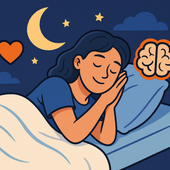
Why Emotional Resilience Improves Sleep
Emotional resilience isn’t just about mental strength—it’s also a key ingredient for better sleep. When your emotions are balanced, your body releases fewer stress hormones, your mind quiets faster, and your sleep becomes deeper and more restorative. Learn how to cultivate calm through mindset, breathwork, and daily habits. 🌙
-
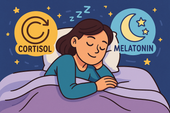
The Connection Between Stress Hormones and Sleep
Chronic stress can quietly reshape your body’s chemistry, raising cortisol, disrupting sleep, and draining your energy. This guide explores how long-term stress affects your nervous system, hormones, and rest—and how to restore calm through breathwork, nutrition, and daily recovery rituals. 🌿
-
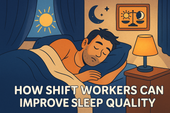
How Shift Workers Can Improve Sleep Quality
For shift workers, caffeine can be both a lifeline and a sleep disruptor. Learn how to use it strategically—boosting alertness during work hours without sabotaging rest. This guide explores timing, dosage, and smarter natural alternatives to keep your energy steady and your sleep restorative. 🌙
-
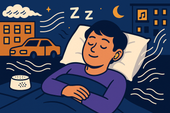
How to Sleep Better in a Noisy Environment
Living in a noisy area doesn’t mean sacrificing your rest. Learn practical and natural strategies to sleep better in loud environments—from using sound masking and breathwork to creating calming rituals that help your brain tune out the chaos. Find inner silence even when the world outside won’t quiet down. 🌙
-

Natural Solutions for Restless Leg Syndrome (RLS)
Struggling to sleep deeply and wake refreshed? This soothing guide explores how the body restores itself during quality sleep—and how to support it naturally. Learn about the science of rest, the role of nutrients, and the rituals that promote deep, uninterrupted slumber. 🌙
-
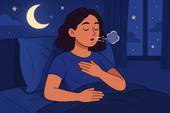
How to Overcome Middle-of-the-Night Anxiety
Middle-of-the-night anxiety can make even the calmest mind spiral into worry. This guide reveals practical, evidence-based techniques to help you stop the 3 A.M. overthinking loop—from breathwork and journaling to herbal supplements and therapy-based tools. Learn to retrain your nervous system and find peace when the world is asleep. 🌙
-

The Perfect Evening Herbal Blend
Discover the calming power of nature in your teacup. The perfect evening herbal blend combines chamomile, lemon balm, lavender, and adaptogens like ashwagandha to relax your body and quiet your mind before bed. Learn how to craft and customize a soothing, sleep-enhancing tea ritual that helps you unwind, restore, and wake up refreshed. 🌙
-
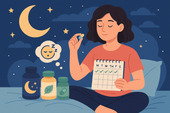
How to Cycle Sleep Supplements for Maximum Effectiveness
Wondering why your sleep supplements stop working after a while? This guide breaks down how to cycle sleep aids like melatonin, magnesium, and ashwagandha for consistent, long-term results. Learn when to rest your body, how to prevent tolerance, and what natural methods—like breathwork and therapy—enhance your sleep cycles. 🌙
-
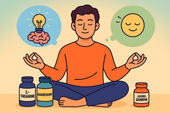
The Best Supplements for Both Relaxation and Focus
Calm your mind and sharpen your focus with the perfect blend of natural supplements. From L-theanine and magnesium to Rhodiola and Lion’s Mane, this science-based guide shows how to achieve relaxation and clarity at the same time. Discover stacks that support your nervous system, balance mood, and keep your mind laser-focused without the crash. 🌿
-

How to Sleep Better During Travel
Traveling can be thrilling—but sleepless nights can ruin even the best trips. From supplements like magnesium and melatonin to soothing breathwork and therapy-based techniques, this guide shows you how to sleep deeply on planes, in hotels, or across time zones. Learn to calm your body, reset your circadian rhythm, and build rest rituals that work anywhere in the world 🌙
-
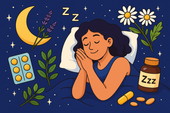
Improving Sleep in Menopause with Supplements
Menopause can make peaceful sleep feel impossible — but balance is within reach 🌿. This article explores how supplements like magnesium, ashwagandha, and black cohosh can ease night sweats, calm the mind, and restore your natural sleep rhythm during hormonal changes.
-
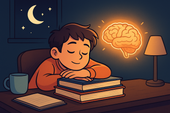
Sleep Support for Students During Exams
Exam stress can make it hard to rest — but sleep is what helps you perform your best 💤. This article explains how to improve sleep quality during exams through better study habits, natural supplements, breathwork, and therapy tools to calm the mind and sharpen focus.
-

Rest Strategies for Entrepreneurs
Entrepreneurs often burn out chasing their vision — but rest is the real fuel for success 🌙. This article explores science-backed recovery strategies for founders, including sleep, breathwork, therapy, and nutrition techniques that sharpen creativity and sustain performance.


















































